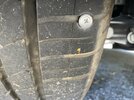I got a nail in my tire a month ago and took it to multiple shops. Per google, the puncture is too close to the side wall to be repaired. But one shop just plugged it for me.
It held up PSI find for a few weeks but lately it's been losing slowly losing pressure over the course of a 2 days down to 39 from 42.
Can this be patch repaired? Thanks!
Yes, but the results will likely remain the same - intermittent air loss.
The reason you don't patch holes near (within 1") the sidewall is because constant tire flex may undermine the patch's seal, over time.
Sidewall flexes as the tire rolls under the weight of the car, and the area of the tread nearest to the sidewall experiences maximum shape distortion. Normally, that constant twisting flexes the sidewall and the friction is enough to generate heat in the tire. If you run the tire too low on air, the flex will overheat the sidewall of the tire and it will disintegrate.
Now add any form of a patch into the mix (plugs that extend into the hole from the inside are the best and longest lasting!), and you can see how the surface area of the plug will be put under exponentially increased amount of stress as you get closer to the sidewall.
Will in fail catastrophically? Probably not.
But the patch has an increased probability to fail over time, and no tire shop wants to deal with unhappy customers who will blame patch failure on the shop and demand compensation, at best. Or free replacement tire at worst. There is ZERO upside to a tire shop to take on that extra risk, especially when the alternative is to sell you a new tire(-s) at much higher margin.
You had already repaired the hole once, and it is leaking air again. How exactly was the patch applied?
You can try more involved and more expensive methods of repair, or spray some sealant goo on the inside, or cut your losses and buy a new tire.
[...]when a repaired tire goes blooey at speed and flips the car off the road, over the guardrail, and down the cliff.
[...]Stop dicing with death and replace the tire already.
There is absolutely no need to be melodramatic.
The repair may fail and start leaking air, but that is no more or less dangerous then any new puncture you may pickup on the road. Tires do not go "blooye" and cars don't "flip off the road". That's comically ridiculous.
Can this be patch repaired? Thanks!
Patch can be replaced and a more durable repair applied in its place.
But if you can't DIY the repair and don't have any more shops to rely on, realistically, you have only one remaining course of action - buy a new set of tires (keep same tread depth on an axle).
Personally, I've gone both ways.
I had had many tires patched (now I just
DIY that with Dynaplug and carry a kit in EVERY car).
And occasionally, when there is sidewall damage after someone drove too long on low pressure, or one time when I took a direct metal plate into the sidewall, I replaced two tires on the impacted axle.
HTH,
a




